| Image | Title | Artist | Collection |
|---|
 | (†)A Lady with a Parrot and a Gentleman with a Monkey [18] [19] [20] | Caspar Netscher | Columbus Museum of Art |
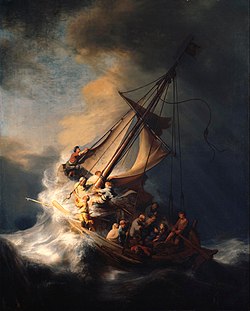 | Christ in the Storm on the Sea of Galilee [21] [22] | Rembrandt | Isabella Stewart Gardner Museum |
| (†)River Landscape Near a Town [23] [24] [25] | unknown Netherlandish artist | Musée Charles de Bruyères
(in Remiremont) |
| A Church Interior with Elegant Company Attending a Christening [26] [27] | Dirck van Delen | private |
 | The Farm [28] [29] | Adriaen van de Velde | Gemäldegalerie |
| The Vegetable Seller [30] [31] | Willem van Mieris | Musée Bernard d'Agesci
(in Niort) |
 | (†)Easy Come, Easy Go [32] [33] [34] | Jan Steen | Museum Boijmans Van Beuningen |
| Bathsheba [35] [36] | Willem van Mieris | Snite Museum of Art |
| The Onion Seller [37] [38] | Willem van Mieris | Musée Bernard d'Agesci
(in Niort) |
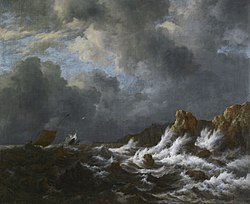 | View from the Coast of Norway [39] [40] | Jacob van Ruisdael | Calouste Gulbenkian Museum |
 | (†)Figures with Horses by a Stable [41] [42] [43] | Paulus Potter | Philadelphia Museum of Art |
 | Italianate Landscape with Cattle [44] [45] | Karel Dujardin | Mauritshuis |
| (†)The Robbery [46] [47] [48] | Simon Kick | Gemäldegalerie |
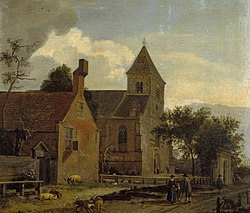 | The Church at Maarssen [49] [50] | Jan van der Heyden | National Trust
(at Polesden Lacey) |
| Man and a Page Offering Fruit to a Seated Woman, In a Courtyard [51] [52] | Jan van Mieris | private |
| Cows and Herdsman by a River [53] [54] | Aelbert Cuyp | The Frick Collection |
 | The Dancing Couple [55] [56] | Jan Steen | National Gallery of Art |
 | (†)The Old Violinist [57] [58] [59] | Frans van Mieris the Elder | Rose-Marie and Eijk van Otterloo Collection,
Museum of Fine Arts, Boston |
| Landscape with Tower [60] [61] | Peter Paul Rubens | Gemäldegalerie |
 | Landscape with Bridge, Cattle, and Figures [62] [63] | Jacob van Ruisdael | Clark Art Institute |
 | (†)Cattle and Sheep in a Stormy Landscape [64] [65] [66] | Paulus Potter | The National Gallery |
 | Woman Drinking with Soldiers
(French: La Buveuse) [67] [68] | Pieter de Hooch | Musée du Louvre |
| The Death of Cleopatra [69] [70] | Gerard de Lairesse | Art Gallery of Ontario |
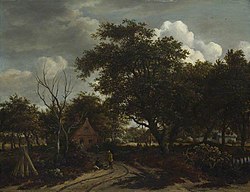 | Cottages in a Wood [71] [72] | Meindert Hobbema | The National Gallery |
 | (†)Elegant Couple in an Interior [73] [74] [75] | Eglon van der Neer | private |
 | Woman Reading a Letter [76] [77] | Gabriël Metsu | National Gallery of Ireland |
| Lot and his Daughters [78] [79] | Adriaen van der Werff | Schlossmuseum Gotha
(within Friedenstein Castle) |
 | Swans and Peacocks [80] [81] | Melchior d'Hondecoeter | Museu Nacional de Belas Artes |
 | Woman Asleep [82] [83] | Gerrit Dou | Hohenbuchau Collection,
on permanent loan to
Liechtenstein. The Princely Collections |
 | Street in Front of the Haarlem Gate in Amsterdam [84] [85] | Jan van der Heyden | Gemäldegalerie |
| Two Ladies with a Parrot at a Casement [86] [87] | Philip van Dijk | private |
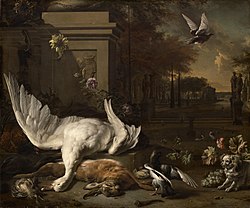 | Still Life with Swan and Game before a Country Estate [88] [89] | Jan Weenix | National Gallery of Art |
 | A Dutch Three-Master and a Boeier in Stormy Weather [90] [91] | Willem van de Velde the Younger | National Trust
(at Buckland Abbey) |
 | Doubting Thomas (The Incredulity of St. Thomas) [92] [93] | Adriaen van der Werff | Milwaukee Art Museum |
 | The Glass of Wine [94] [95] | Johannes Vermeer | Gemäldegalerie |
| Three Soldiers Making Merry [96] [97] | Gerard ter Borch | private |
| Landscape with kermis
(or The Rustic Wedding) [98] [99] | Philips Wouwerman | Mansion House, London |
| Roman Market Scene [100] [101] | Johannes Lingelbach | Staatliche Kunsthalle Karlsruhe |
 | Man Writing a Letter [102] [103] | Gabriël Metsu | National Gallery of Ireland |
| A Guardroom Scene with Tric-Trac Players in the Foreground [104] [105] | David Teniers the Younger | private |
 | (†) A Lady and Gentleman in Black [106] [107] [108] | Rembrandt | Isabella Stewart Gardner Museum |
| An Italian Landscape [109] [110] | Jan Both | National Gallery of Ireland |
 | Dutch Shipping in a Heavy Swell with a Small Hoeker [111] [112] | Willem van de Velde the Younger | National Trust
(at Buckland Abbey) |
 | The Virgin as Intercessor [113] [114] | Anthony van Dyck | National Gallery of Art |
| View of the Roman Forum [115] [116] | Jacob van der Ulft | Schloss Collection,
looted during World War II |
 | Officer Writing a Letter, with a Trumpeter [117] [118] | Gerard ter Borch | Philadelphia Museum of Art |
 | The Christening [119] [120] | Jan Steen | Gemäldegalerie |
 | The Music Lesson [121] [122] | workshop of
Gerard ter Borch | Isabella Stewart Gardner Museum |
 | (†)The Cottage Dooryard [123] [124] [125] | Adriaen van Ostade | National Gallery of Art |
| Landscape with Cattle [126] [127] | Adriaen van de Velde | Philadelphia Museum of Art |
 | Old Woman Peeling Apples [128] [129] | Nicolaes Maes | Gemäldegalerie |
 | A Lady at Her Toilet [130] [131] | Gabriël Metsu | The Frick Collection |
|



































